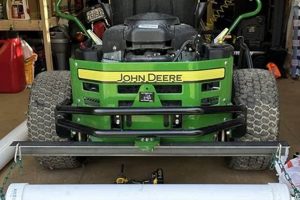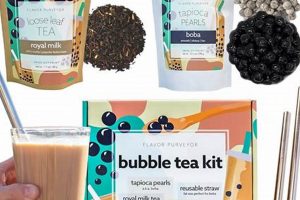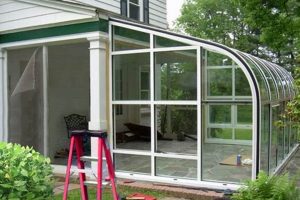A do-it-yourself project designed for crafting alcoholic spirits at home, typically includes the components and instructions necessary to infuse neutral grain alcohol with flavors intended to mimic aged whiskey. These sets often contain wood chips (such as oak), spices, and other botanicals used to impart color, aroma, and taste profiles similar to traditionally distilled and barrel-aged whiskeys. A common example might include a glass bottle, a selection of toasted oak chips of varying char levels, and a blend of spices like vanilla bean, cinnamon, and cloves.
The increasing popularity of at-home spirit crafting stems from a desire for personalized experiences, cost savings, and a deeper understanding of flavor development. Historically, home brewing and distilling were common practices; the resurgence of this interest aligns with broader trends in artisanal food and beverage production. The potential benefits include the ability to experiment with different flavor combinations, tailor the product to individual preferences, and gain insight into the complex processes involved in commercial whiskey production.
The following sections will explore the components commonly found in these sets, examine the process of using them to create a whiskey-like spirit, and discuss the legal and safety considerations associated with such undertakings. Furthermore, the exploration will extend to evaluate the quality and potential outcomes compared to commercially available whiskeys.
Essential Considerations for Assembling Your Own Whiskey Creation Set
The successful creation of a palatable spirit requires careful attention to detail. The following tips aim to guide the process and optimize the final product.
Tip 1: Sourcing Quality Ingredients: The foundation of any desirable spirit lies in the quality of its components. Opt for neutral grain alcohol from reputable suppliers. Verify the origin and grade of wood chips; American or French oak, appropriately toasted, is generally preferred.
Tip 2: Managing Oak Contact Time: Wood imparts significant flavor and color. Excessive contact can lead to an overly tannic and bitter product. Begin with shorter infusion times (e.g., 1-2 weeks) and taste regularly. Adjust the duration based on preference.
Tip 3: Optimizing Spice Blends: Spices should complement, not dominate, the oak influence. Start with small quantities of spices like vanilla, cinnamon, or cloves. Gradual additions allow for precise flavor calibration.
Tip 4: Filtration and Clarity: After infusion, filtration is crucial to remove sediment and improve clarity. Utilize a coffee filter or cheesecloth to remove larger particles. Further clarification may require specialized filtration equipment.
Tip 5: Dilution and Proofing: Most neutral grain spirits are higher in alcohol content than typical whiskeys. Dilute the infused spirit with distilled water to achieve the desired proof (typically 40-45% ABV). Accurate measurement is essential.
Tip 6: Temperature Control: The infusion process is sensitive to temperature fluctuations. Maintain a consistent and cool environment to ensure uniform extraction of flavors from the wood and spices.
Tip 7: Record Keeping: Meticulously document the amounts of each ingredient used, infusion times, and any other relevant parameters. Accurate records facilitate replication and refinement of successful batches.
Employing these strategies will enhance the likelihood of producing a spirit with desirable characteristics, mitigating potential pitfalls that may compromise the final product.
The subsequent sections will elaborate on specific flavor profiles, potential variations, and considerations for scaling up production, providing a more comprehensive understanding of the whiskey-making process.
1. Oak Infusion
Oak infusion is a critical element in the creation of spirit flavor and aroma profiles using do-it-yourself whiskey creation sets. It attempts to mimic, on a condensed timescale, the traditional barrel-aging process that defines the characteristics of commercially produced whiskey.
- Oak Species and Flavor Contribution
The type of oak employed significantly influences the final product. American white oak (Quercus alba) is frequently used for its vanillin and lactone contributions, imparting vanilla and coconut notes. French oak (Quercus robur or Quercus petraea), typically more expensive and less common in starter sets, contributes spicier and more subtle tannin profiles. The specific oak species dictates the range of potential flavors extracted during the infusion process.
- Toast Level and Compound Release
Toasting the oak releases volatile compounds that contribute to the spirit’s complexity. Lightly toasted oak provides subtle sweetness and vanilla, while heavily toasted oak yields caramel, toffee, and smoky notes. Charred oak, resulting from extreme toasting, introduces dark, bitter flavors. The diy whiskey kit should provide oak chips with an optimal toasting level for initial infusion, often described as medium or medium-plus.
- Surface Area and Extraction Rate
The surface area of the oak in contact with the neutral spirit influences the rate of flavor extraction. Smaller oak chips offer a larger surface area relative to their volume, leading to faster infusion. Large oak staves provide a slower, more controlled extraction. The kits typically use chips to expedite the process, necessitating careful monitoring to prevent over-extraction and excessive tannin release.
- Duration and Temperature of Infusion
The duration of oak infusion directly correlates with the intensity of flavor and color development. Extended infusion times lead to a darker spirit with pronounced oak character. Temperature also impacts the extraction rate, with warmer temperatures accelerating the process. Users of diy whiskey kits must carefully control these parameters to achieve the desired outcome, tasting frequently and adjusting infusion time as needed.
The interplay of these oak-related factors within a do-it-yourself setting determines the spirit’s resemblance to traditionally aged whiskey. While these kits can offer a degree of flavor approximation, they do not fully replicate the complexities achieved through extended barrel aging and genuine distilliation processes. Success relies heavily on quality control and user experimentation.
2. Spice blending
Spice blending, in the context of a do-it-yourself whiskey creation set, represents a critical element in achieving a desired flavor profile that mimics traditionally produced whiskeys. It introduces complexity and depth that oak infusion alone cannot provide. The selection and proportion of spices require careful consideration to avoid overpowering the spirit or creating an unbalanced flavor profile.
- Pur
pose and Flavor EnhancementSpices serve to augment the flavor notes derived from oak infusion, adding layers of complexity and nuance. They can replicate the characteristics found in aged whiskeys, such as vanilla, caramel, or subtle spice undertones. The strategic use of spices helps to mask any harshness present in the neutral grain spirit used as a base and contributes to a more palatable final product.
- Common Spice Components and Characteristics
Typical spices found in these sets include vanilla bean, cinnamon sticks, cloves, allspice berries, and dried orange peel. Vanilla contributes sweetness and creamy notes, cinnamon provides warmth and spice, cloves offer a pungent and slightly bitter flavor, allspice delivers a complex blend of cinnamon, cloves, and nutmeg, and dried orange peel adds a citrusy aroma. The specific combination and ratio of these components determine the overall flavor profile.
- Blending Ratios and Flavor Balance
Precise measurements are crucial when blending spices. Overuse of any single spice can lead to an unbalanced flavor profile. Experimentation with small quantities is recommended to achieve the desired result. A common approach involves starting with a base blend and gradually adding individual spices to fine-tune the taste. Recording measurements allows for replication of successful blends and adjustments for future iterations.
- Infusion Time and Flavor Extraction
The duration of spice infusion directly affects the intensity of flavor extraction. Shorter infusion times yield subtle spice notes, while longer durations result in more pronounced flavors. Regular tasting during the infusion process is essential to prevent over-extraction, which can lead to undesirable bitterness or harshness. The optimal infusion time depends on the type of spirit used, the spice blend, and individual preferences.
The judicious use of spice blending within a do-it-yourself spirit creation context represents a crucial stage in achieving a product that emulates the flavor complexities of traditional whiskeys. This process, in conjunction with oak infusion, allows for personalized flavor manipulation, albeit within the limitations imposed by the absence of genuine distillation and maturation processes. The quality and balance of the final product hinge upon careful component selection, precise measurement, and diligent flavor monitoring.
3. Neutral spirit
The neutral spirit constitutes a foundational element within any do-it-yourself whiskey creation set. Its inherent properties directly influence the character of the final product, making its selection and handling of paramount importance to the success of the endeavor.
- Definition and Composition
A neutral spirit, also known as neutral grain spirit (NGS) or ethyl alcohol, is a highly rectified alcoholic beverage distilled from grains, potatoes, or other fermentable agricultural products. It is characterized by its high alcohol content (typically 95% ABV or 190 proof) and relative lack of flavor, color, and aroma. The absence of these attributes allows it to serve as a blank canvas for the infusion of flavors during the whiskey creation process.
- Role in Flavor Acquisition
Within the confines of a do-it-yourself kit, the neutral spirit serves as the solvent and medium for extracting flavors from oak chips, spices, and other botanicals. It absorbs and integrates the volatile compounds released during infusion, creating a spirit that approximates the flavor profile of traditionally aged whiskey. The quality of the neutral spirit significantly impacts the efficiency of this extraction and the overall palatability of the final product.
- Impact on Final Product Quality
While a neutral spirit is intended to be flavorless, subtle variations in its production process can affect the final outcome. Impurities or congeners present in the spirit, even in minute quantities, can manifest as off-flavors or detract from the desired flavor profile. Sourcing a high-quality neutral spirit from a reputable supplier is crucial to minimize these potential issues.
- Legality and Safety Considerations
The legal status of using neutral spirits in this context varies by jurisdiction. Individuals should verify local regulations regarding the purchase, possession, and use of high-proof alcohol before engaging in do-it-yourself spirit creation. Furthermore, safety precautions are paramount when handling high-proof alcohol, including ensuring adequate ventilation and avoiding open flames or sources of ignition.
In summary, the neutral spirit is not merely an inert base but an active participant in the flavor development process within a do-it-yourself spirit project. Its inherent qualities, sourcing, and handling all significantly contribute to the success or failure of the attempt to emulate the characteristics of a traditional whiskey.
4. Aging process
The aging process, a fundamental aspect of traditional whiskey production, presents a significant challenge within the context of a do-it-yourself kit. Kits attempt to replicate, on a condensed timescale, the complex chemical reactions and flavor transformations that occur during years of barrel maturation.
- Accelerated Maturation Techniques
Diy whiskey kits rely on accelerated aging methods, primarily through the use of oak chips or staves. These components provide a large surface area for flavor extraction, aiming to mimic the impact of a full-sized barrel. However, the rapid extraction often results in a less nuanced flavor profile compared to traditional aging, where slow, gradual interaction between spirit and wood occurs over extended periods.
- Oxidation and Micro-oxygenation
Traditional barrel aging involves slow oxidation, a process that contributes to the softening of harsh flavors and the development of desirable esters and aldehydes. Diy kits typically lack this controlled oxidation environment. While some kits may suggest aeration techniques, they cannot fully replicate the micro-oxygenation afforded by porous oak barrels, thus limiting the development of complex flavors.
- Temperature and Environmental Control
Traditional aging warehouses experience seasonal temperature fluctuations, which drive the spirit in and out of the oak, enhancing flavor extraction. Diy kits, often stored at room temperature, do not replicate these conditions. The lack of temperature variation can lead to a less dynamic and less complex flavor profile.
- Tannin Management and Extraction
Oak barrels impart tannins, which contribute to the whiskey’s structure and mouthfeel. However, excessive tannin extraction can result in bitterness. Diy kits, with their accelerated aging, often struggle to manage tannin extraction effectively. Careful monitoring and controlled infusion times are crucial to prevent an overly tannic final product.
While diy whiskey kits can offer a degree of flavor approximation, they cannot fully replicate the complexities achieved through extended barrel aging. The accelerated techniques employed often result in a less refined and less nuanced final product compared to commercially produced whiskeys that undergo traditional maturation processes. Under
standing the limitations of these kits in replicating the aging process is crucial for setting realistic expectations.
5. Filtration method
The filtration method represents a pivotal stage in the creation of a spirit using do-it-yourself whiskey creation sets. Its primary purpose is to remove particulate matter and clarify the liquid, enhancing its visual appeal and potentially refining its flavor profile.
- Sediment Removal and Clarity Enhancement
During the infusion process, oak particles, spice fragments, and other insoluble compounds can become suspended in the spirit. Filtration removes these solids, preventing cloudiness and improving the spirit’s clarity. The resulting product presents a more refined appearance, mirroring the visual characteristics of commercially produced whiskeys.
- Flavor Refinement and Tannin Management
While filtration primarily targets particulate matter, it can also influence the flavor profile. In some instances, filtration may reduce the concentration of harsh tannins extracted from the oak, leading to a smoother, less bitter taste. However, excessive filtration could also remove desirable flavor compounds, potentially diminishing the overall complexity of the spirit.
- Available Filtration Techniques and Equipment
A range of filtration techniques can be employed, from simple methods like using coffee filters or cheesecloth to more sophisticated approaches involving laboratory filter paper or specialized filtration equipment. The choice of method depends on the desired level of clarity and the resources available. More advanced techniques offer finer filtration, but may also require greater technical expertise.
- Impact on Long-Term Stability
Effective filtration contributes to the long-term stability of the spirit. By removing particulate matter that could serve as nucleation sites for precipitation or microbial growth, filtration helps to prevent cloudiness or spoilage over time. This ensures that the spirit retains its clarity and flavor integrity during storage.
The selection and execution of the filtration method play a crucial role in determining the final quality and appeal of a spirit created using a do-it-yourself whiskey creation set. While filtration cannot replicate the aging process or fundamentally alter the spirit’s composition, it serves as a critical finishing step, enhancing its visual and gustatory characteristics.
6. Safety precautions
The integration of safety precautions is paramount when utilizing a do-it-yourself whiskey creation kit. The kits involve handling high-proof alcohol, which presents inherent risks if mishandled. Failure to adhere to safety guidelines can result in fire hazards, skin irritation, or ingestion-related health problems. For instance, improper storage of neutral grain spirits near open flames or heat sources could lead to accidental ignition. The absence of adequate ventilation during mixing or bottling can concentrate flammable vapors, increasing the risk of explosion. These examples underscore the causal relationship between neglecting safety protocols and potential adverse outcomes.
A critical safety measure involves understanding the flammability of high-proof alcohol and implementing appropriate safeguards. This includes working in well-ventilated areas, away from ignition sources, and using containers designed for storing flammable liquids. Another key consideration is the potential for skin irritation from prolonged contact with undiluted alcohol. Protective gloves should be worn during handling to minimize exposure. Furthermore, accidental ingestion of high-proof alcohol can lead to alcohol poisoning, necessitating immediate medical attention. Kits should be stored out of reach of children and pets to prevent unintended consumption. Clear and concise instructions regarding these risks should be prominently displayed within the kit’s packaging.
In summary, the observance of safety precautions is not merely an ancillary aspect of using a do-it-yourself whiskey creation kit, but rather an indispensable component. By proactively addressing the potential hazards associated with handling high-proof alcohol and implementing appropriate safeguards, users can mitigate risks and ensure a safe and enjoyable experience. The practical significance of this understanding lies in preventing accidents, protecting health, and promoting responsible experimentation within the confines of the at-home spirit creation process.
7. Legal compliance
The intersection of “diy whiskey kit” and legal compliance is a complex one, governed by regulations varying significantly across jurisdictions. The legality of creating whiskey-like spirits at home hinges primarily on whether the process constitutes illegal distillation or merely flavoring a legally obtained neutral spirit. Distillation, the process of separating alcohol from a fermented substance, is often heavily regulated and requires specific licenses and permits. Many jurisdictions prohibit unlicensed distillation, regardless of the scale or intended use of the product.
The “diy whiskey kit,” therefore, attempts to navigate this legal landscape by providing components for flavoring a pre-existing, legally purchased neutral spirit, rather than facilitating its distillation. However, the line between permissible flavoring and illegal distillation can be blurred, particularly if the kit is marketed in a way that implies the user is creating “whiskey” in the traditional sense. Furthermore, labeling regulations may restrict the use of terms like “whiskey” or “bourbon” if the resulting product does not meet the legal definitions for these spirits. The consequences of non-compliance can range from fines and product seizure to criminal charges, depending on the severity of the violation and the specific laws in effect.
In summary, engaging with a “diy whiskey kit” necessitates a thorough understanding of local, regional, and national alcohol regulations. The act of flavoring a spirit is generally permissible, but the implication of distillation or misrepresentation of the final product as a legally defined spirit can trigger legal ramifications. The practical significance of this understanding lies in ensuring that individuals engage with these kits responsibly and lawfully, avoiding potential penalties and promoting adherence to established alcohol control measures. This careful approach protects both the individual and the integrity of the regulated spirits industry.
Frequently Asked Questions About Do-It-Yourself Whiskey Creation Kits
This section addresses common inquiries and concerns surrounding do-it-yourself whiskey creation kits, providing clarity and factual information to guide informed decisions.
Question 1: Can a “diy whiskey kit” truly replicate the flavor of aged whiskey?
These kits aim to approximate the flavor profiles of aged whiskeys through accelerated infusion of oak and spices. However, they cannot fully replicate the complex chemical reactions and slow maturation process that occur during years of traditional barrel aging. The resulting flavor is typically less nuanced a
nd lacks the depth of commercially produced whiskeys.
Question 2: Is using a “diy whiskey kit” legal?
The legality depends on local regulations. Generally, flavoring a legally purchased neutral spirit is permissible. However, distilling alcohol without proper licensing is often prohibited. Marketing or representing the final product as a legally defined spirit (e.g., “bourbon”) without meeting the specific requirements may also be unlawful. It is crucial to verify local alcohol regulations.
Question 3: What are the key components of a typical “diy whiskey kit”?
A typical kit includes a glass bottle or container, a selection of oak chips (often with varying toast levels), a blend of spices (such as vanilla, cinnamon, cloves), and instructions. Some kits may also include a hydrometer for measuring alcohol content and filtration materials.
Question 4: What are the potential risks associated with using a “diy whiskey kit”?
Potential risks include handling high-proof alcohol, which is flammable and can cause skin irritation. Improper storage or handling can lead to fire hazards. Over-extraction of tannins from oak can result in a bitter-tasting product. Inaccurate measurements of spices can lead to unbalanced flavor profiles. It is essential to follow safety guidelines carefully.
Question 5: How long does it take to create a whiskey-like spirit using a “diy whiskey kit”?
The infusion process typically takes several weeks, depending on the desired intensity of flavor. Regular tasting is recommended to monitor the progress and prevent over-extraction. Some kits may suggest a shorter infusion time, while others recommend longer periods. The duration depends on the specific kit components and individual preferences.
Question 6: What is the shelf life of a spirit created using a “diy whiskey kit”?
The shelf life depends on several factors, including the quality of the neutral spirit used, the effectiveness of filtration, and the storage conditions. Properly filtered and stored spirits can remain stable for several months. However, over time, the flavor profile may change due to oxidation or other chemical reactions. It is advisable to consume the spirit within a reasonable timeframe for optimal taste.
In conclusion, do-it-yourself whiskey creation kits offer a means of experimenting with spirit flavoring, but they are not a substitute for traditional whiskey production. Understanding the limitations, risks, and legal considerations associated with these kits is crucial for responsible and informed use.
The following section will explore advanced techniques for customizing spirit creation, delving into more sophisticated flavoring methods and refinement strategies.
Conclusion
This exploration has illuminated the complexities inherent in the do-it-yourself whiskey kit phenomenon. From ingredient selection and blending techniques to legal compliance and safety precautions, the creation of a palatable spirit necessitates a comprehensive understanding of the underlying principles. While these kits offer a simplified approach to spirit flavoring, they cannot fully replicate the intricacies of traditional whiskey production.
The information presented serves as a foundation for informed decision-making regarding engagement with the “diy whiskey kit”. Further exploration of advanced techniques and adherence to best practices will enhance the probability of achieving desirable results. Ultimately, responsible experimentation and a critical evaluation of the final product will determine the true value and applicability of this at-home spirit creation endeavor.







